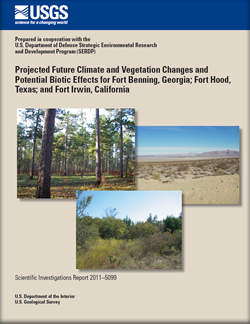 Abstract Abstract
The responses of species and ecosystems to future climate changes will present challenges for conservation and natural resource managers attempting to maintain both species populations and essential habitat. This report describes projected future changes in climate and vegetation for three study areas surrounding the military installations of Fort Benning, Georgia, Fort Hood, Texas, and Fort Irwin, California. Projected climate changes are described for the time period 2070–2099 (30-year mean) as compared to 1961–1990 (30-year mean) for each study area using data simulated by the coupled atmosphere-ocean general circulation models CCSM3, CGCM3.1(T47), and UKMO-HadCM3, run under the B1, A1B, and A2 future greenhouse gas emissions scenarios. These climate data are used to simulate potential changes in important components of the vegetation for each study area using LPJ, a dynamic global vegetation model, and LPJ-GUESS, a dynamic vegetation model optimized for regional studies. The simulated vegetation results are compared with observed vegetation data for the study areas. Potential effects of the simulated future climate and vegetation changes for species and habitats of management concern are discussed in each study area, with a particular focus on federally listed threatened and endangered species.
1U.S. Geological Survey, Corvallis, Oregon.
2School of Forest Resources, University of Washington, Seattle, Washington.
3Department of Geography, University of Oregon, Eugene, Oregon.
4Department of Earth and Ecosystem Sciences, Lund University, Lund, Sweden.
5Current address: Scientific Certification Systems, Emeryville, California.
6Current address: Department of Biology, Southern Utah University, Cedar City, Utah.
|
First posted April 20, 2012
This report is presented in Portable Document Format (PDF); the latest version of Adobe Reader or similar software is required to view it. Download the latest version of Adobe Reader, free of charge. |